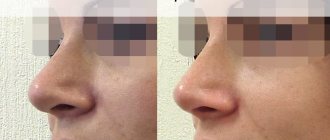What to do if your nose shape is unattractive from birth? What if the nose does not perform its function well enough? Rhinoplasty can fix this incredibly easily. Before and after rhinoplasty is one of the most frequently asked questions by our clients. And now we will consider this topic in depth.
The nose is the part of the body that immediately attracts attention - whether we want it or not. Of course, not everyone has to have an adorable, envy-worthy “button nose”; just as not every one of us requires the same delicate sense of smell as a worker in the wine or perfume industry. The main thing is that we are happy with the appearance of our nose and that when we breathe, it allows air to pass freely.
Before and after nose surgery. 4 reasons to see a surgeon:
- Self-satisfaction increases . How we feel internally largely determines how we relate to the world around us.
- The overall quality of life will increase significantly, because from now on you will finally be happy with your appearance or will finally be able to breathe freely, without difficulty. Many new opportunities will open up for you - you will be able to attend training, take part in social events, etc. Rhinoplasty, among other things, will have a positive impact on your intimate life.
- For those whose nose causes medical difficulties, not only their mental state will improve, but also their physical well-being.
- Due to the domino effect, your social life will also improve and your success in the professional sphere will increase . You will feel great in your body, and this feeling will seem to radiate outward, in turn positively influencing various relationships.
The nose will change, but will the face change?
In recent years, doctors themselves have looked at rhinoplasty with a different perspective and approach this operation comprehensively. After all, beauty is not only the beautiful shape of the nose or the oval of the face, but the harmony of the face as a whole. Very often, to achieve this harmony, it is necessary, for example, to slightly extend the chin, remove bags under the eyes, enlarge the lips or change their shape, and raise the eyebrows. And if the patient is aged, then the surgeon performing rhinoplasty can slightly tighten the wrinkles and perform neck liposuction. In addition, protruding ears are sometimes eliminated along with rhinoplasty.
What should you remember after a nose job?
Rhinoplasty allows you to reduce or, conversely, increase the nasal bone or cartilage tissue. As a rule, the operation is performed under general anesthesia; The postoperative recovery period takes approximately one to one and a half weeks.
After the operation, bed rest is prescribed; in this case, the head - in order to minimize swelling and bleeding - should be higher than the chest. Keep in mind that swelling and some nasal congestion may occur during this time. For several days, a small amount of blood and mucus may be released from the nose - these are all natural processes of the postoperative period.
NB! There are no universal methods of rhinoplasty; it is performed differently on each patient, and its results are always very individual.
Plastic surgeon Amina Kibisheva: “Nothing changes the expression and harmony of the face like the shape of the nose”
Of all the options for plastic surgery on the face, rhinoplasty stands out. She can rightfully be called the queen of aesthetic surgery, because it is a well-groomed profile and a clear full face that can ennoble a person’s appearance and improve the perception of a person by others.
Leading specialist at the LuxCLINIC plastic surgery and cosmetology clinic, Candidate of Medical Sciences Amina Kibisheva spoke about this interesting operation, as well as about other popular areas of facial plastic surgery:
Amina, why does rhinoplasty occupy such an honorable place in plastic surgery?
– Nothing changes the expression and harmony of the face more than the shape of the nose. Depending on it, a person’s perception is formed and, to some extent, the patient’s character is reflected. Rhinoplasty is one of the most complex aesthetic operations and the problem lies in the fact that the doctor, even in the preoperative period, must have a clear understanding of what changes will be made during the operation, taking into account the wishes of the patient, the initial state of the tissues of the intended correction area and the doctor’s experience.
Any slightest inaccuracy, unnecessary removal of cartilage or bone structures will later manifest itself and become noticeable, leading to deformation of the nose, sometimes ending in dissatisfaction and possibly suffering for the patients. It is necessary to preserve the anatomical proportions of the nose as much as possible during the operation.
Some plastic surgeries are performed generally technically the same for all patients, but rhinoplasty is difficult in planning intraoperative manipulations and understanding what the nose will look like after correction. Its results largely depend on the type, thickness, structure of the skin, the number of sebaceous glands and the severity of subcutaneous fat.
What types of rhinoplasty exist and how do they differ from each other?
– There are reconstructive and aesthetic rhinoplasty. Aesthetic rhinoplasty allows you to shape the nose and ensure that its proportions are balanced with facial features with normal, unchanged tissues. Reconstructive rhinoplasty is the restoration of the proportions of the nose in the presence of defects and deformations of various origins.
In aesthetic surgery, we have to deal more with congenital deformities, such as saddle nose (recession in the bone and/or cartilaginous parts), long nose, humpbacked nose and tip deformities.
Can the patient's character change after changing the shape of the nose?
- Partly yes. For many people, a more attractive appearance gives them confidence. For example, a small upturned nose will give a person more tenderness, charm and flirtatiousness than a straight and sharp nose, more suitable for a business woman. If you make a snub nose for a strict academic girl, it may not be in harmony with her inner state.
You also need to take into account the national and ethnic features of appearance - there are several types of noses (oriental, characteristic of the peoples of Asia, Caucasian, Negroid and European), each of which requires an individual approach.
Can secondary rhinoplasty occur in the life of every surgeon?
– Yes, and revision rhinoplasty is technically even more complex than primary nose correction, because There are already surgical changes in the osteochondral pyramid and skin reduction, subcutaneous scarring, especially after aggressive surgical interventions. In this case, aesthetic rhinoplasty turns into reconstructive, and the doctor corrects, recreates the tissue, and possibly eliminates mistakes made at the previous stage.
Also, a frequent reason for revision rhinoplasty may be the patient’s inadequate perception of his new image. Some patients have internal psychological problems. The operation itself can improve their inner sense of self, or it can leave the patient dissatisfied.
Is it possible to give a patient the nose of his dreams?
– It is necessary to very accurately distinguish between surgical possibilities and the wishes of patients. Often, even the patient himself does not know which nose shape to choose. The main thing is to operate in such a way that the wishes are taken into account, but at the same time harmony in appearance is achieved. To do this, you need to take into account the proportions of the upper, middle and lower areas of the face. The face has its own anthropometric proportions and relationships.
Each patient must be approached individually. Knowledge of facial anthropometry can facilitate correct assessment of the size of a defect or deformity, as well as planning a restoration technique.
Is it possible to say that “open” and “closed” rhinoplasty are two autonomous directions that do not compete with each other?
– Open and closed rhinoplasty today are performed equally successfully and each has its own advantages. Open rhinoplasty involves an incision on the skin of the nasal septum and with this access the doctor sees all the structures of the nose in their natural anatomical position without stretching or displacing tissue, which facilitates all stages of the operation, expands technical capabilities, and makes it easier to place and fix grafts. To prevent the effect of skin retraction and deformation on the skin part of the nasal septum after such an operation, the doctor uses a shaped incision in its narrowest part.
Also, only open rhinoplasty should be used in most cases of secondary rhinoplasty, nasal asymmetries, congenital pathology, when reconstructive surgery is performed. It is better for a novice surgeon to give preference to open access for better tissue visualization. Closed rhinoplasty can only be performed by an experienced surgeon. But patients, of course, are more attracted to closed access, which avoids external scars.
Are there other options for nose work other than aesthetic and reconstructive rhinoplasty?
– Yes, often aesthetic rhinoplasty becomes functional, i.e. associated with the restoration of breathing. To restore breathing, a deviated nasal septum is corrected, both its cartilaginous and bone parts - rhinoseptoplasty. The operation can combine vasotomy with conchotomy, correcting the condition of the nasal turbinates, thereby increasing the lumen of the nasal passages.
What materials are preferable when there is a deficiency of nasal tissue?
– The ideal material is the patient’s own tissue. First of all, this is septal cartilage, which is more resistant to resorption, ear or costal cartilage, and cadaveric cartilage is also widely used. There is a wide variety of implants used for the same purposes, but the use of autografts minimizes the risk of tissue resorption, rejection and inflammation.
Blepharoplasty is one of the three most popular operations after mammoplasty and liposuction. What are the indications for this type of surgery?
– Nothing makes your appearance look younger like eyes – and overhanging folds can give your face a tired and senile look. As soon as the eyelids are operated on, the person looks much younger, even if circular correction of atrophy of the tissues of the face and neck was not carried out. It is not recommended to do aesthetic blepharoplasty more than two, maximum three times.
Often after surgery, the effect of sunken eyes appears. What is the surgeon's mistake?
– This is a negative effect obtained due to excessive removal of fat bags in hernias of both the upper and lower eyelids. If an inexperienced physician excessively removes orbital fat, a sunken-eye effect may occur, so minimal interference with the orbital fat on the eyelids should be done.
Radical intervention on the orbital tissue not only aesthetically worsens the external effect, but can lead to problems with the organ of vision. The effect on the eyelids requires delicate handling of tissues. Blepharoplasty on the lower eyelids, in some cases, is performed not with resection, but with redistribution of fat in the area of the nasolacrimal groove.
How to avoid the effect of “operated eyelids”?
– In the pathogenesis of age-related changes in the eyelids, all eyelid tissues are involved, including not only overstretched skin, but also atrophic changes in the orbicularis oculi muscle and adjacent structures, leading to its distensibility, sagging, and decreased tone. There are several surgical treatment methods. There are many conflicting opinions regarding the integrity of the orbicularis oculi muscle of the lower eyelid during surgery - whether to resect a fragment of the muscle or not.
Supporters of muscle preservation see a solution to the problem of “operated eyelids” in removing hernial protrusions through a transconjunctival approach, leaving the orbicularis muscle intact. There is another point of view: the need to resect a fragment of a muscle that is overstretched during age-related changes. To prevent eyelid retraction and rounding of the outer corner of the eye, there are surgical techniques such as myopexy and canthoplasty (suspending the muscle and external ligament of the eye to the periosteum of the orbit). And, of course, minimal skin excision, thus preventing the lag of the lower ciliary edge of the eyelid from the eyeball and eversion of the eyelid.
Whatever technique the doctor knows, the most important thing is preoperative planning, assessment of the condition of tissues, knowledge of anatomy, surgical treatment methods, and a careful, non-aggressive attitude towards tissues.
Where is the suture from the operation and what threads are it formed with?
– The incision on the lower eyelids is made as close to the eyelash line as possible. On the upper eyelids, incisions are made so that the scar is 4-10 mm from the upper ciliary edge, repeating the curve of the natural palpebral fold, which is absent in the Mongoloid eyelid structure. A suture is placed on the skin with a thin non-absorbable thread, which is removed 3-4 days after surgery. In the postoperative period, a complex of rehabilitation measures is possible, aimed at the rapid restoration of lymph and blood circulation.
It is believed that otoplasty is one of the easiest operations, but is it true? What difficulties exist in this direction?
– This is not an easy operation at all. Otoplasty is a large independent direction in aesthetic surgery. The complex topography of the auricle requires recreating the same auricle as nature created it. The etiology of defects and deformations is different.
The most common aesthetic operation is the correction of congenital protruding ears, which can be performed from 5-6 years of age. At this age, the auricle completes its growth. Congenital deformities can be very serious, including the absence of the auricle or underdevelopment of its elements, in combination with a malformation of the inner ear. Reconstruction of the auricle in case of traumatic injuries is no less difficult. Such operations are carried out in several stages and require patience from the patient, psychological assistance, extensive experience, knowledge and skills from the doctor.
How does a plastic surgeon become a professional?
– The path is long and thorny. Becoming a highly qualified specialist is very hard work, requiring great physical effort, great dedication, perseverance, and patience. Experience in general and maxillofacial surgery, microsurgery and craniofacial surgery, ophthalmology, otolaryngology and other related specialties is required, study of professional literature, participation in Russian and international congresses and conferences, where a plastic surgeon can replenish his professional knowledge base, learn from the experience of leading Russian and foreign specialists. A doctor who takes this path should not count on quick and easy success. Plastic surgery is the highest level of professional skill.
Law of dialectics
A woman striving for a change in fate intuitively feels: there is a connection between a person’s internal and external changes. It’s one thing how we feel when we’re standing in a smart dress, it’s another thing in an old robe that doesn’t fit. A military uniform and sword belt will make any man stand up proudly. All this is true. But when we suddenly see: our colleague, whom we have known for so many years, one day comes to work as a transformed, glowing man, completely different from his former self, we understand that he looks this way not because he bought a new shirt or got a good haircut, but because that his appearance had changed under the influence of some internal work. Something happened to his soul, and that’s why his face looks different. To change a face mechanically, with the help of a scalpel, is an attempt to jump over the inner workings of the soul. Without living through some situation, without making an internal metamorphosis, you will receive an external change. That is why the new appearance does not satisfy the patients of plastic surgeons. She cannot satisfy them. A person looks in the mirror and does not recognize himself: this is not what I wanted. And he's right, that's not it. But what he wanted should not be sought from the surgeon.
Contraindications and indications
Aesthetic indications:
- Disproportionality of the size of the nose relative to the face.
- The presence of a tubercle (hump).
- Thickened or very sharp tip.
- Wide wings (nostrils).
Medical indications include structural pathologies that lead to difficulty breathing, sinusitis, otitis media, etc. Over time, a person develops oxygen starvation. This condition is especially dangerous for children.
Contraindications for rhinoplasty:
- Pregnancy period.
- Oncological diseases.
- Diabetes.
- Hemophilia, or a temporary bleeding disorder.
- Anemia.
- Liver and kidney diseases.
- Periods of menstruation.
- Mental illnesses and psychological disorders.
- Age under 18 and over 40.
Portrait in the interior
What can we say about our heroine, who decided to change her face? A psychologist would paint a portrait of her like this. She is probably very lonely, even if she has a husband and children, and suffers from a lack of love. There are many people in the world who are not just ugly, but even ugly, and yet loved and happy, having success with the opposite sex. This means that the matter here is not only in the proportions of facial features.
Our lady is probably dissatisfied with herself. This often happens: dissatisfaction with ourselves results in hatred of some part of our body or some external feature. It seems that if it weren’t for the long nose, or the protruding ears, or the short, plump legs, everything would have turned out differently in life.
But we must give our heroine her due: she is a fighter. He resolutely wants to cross out today’s life in order to start a new life tomorrow.
But didn't she choose the longest path?










